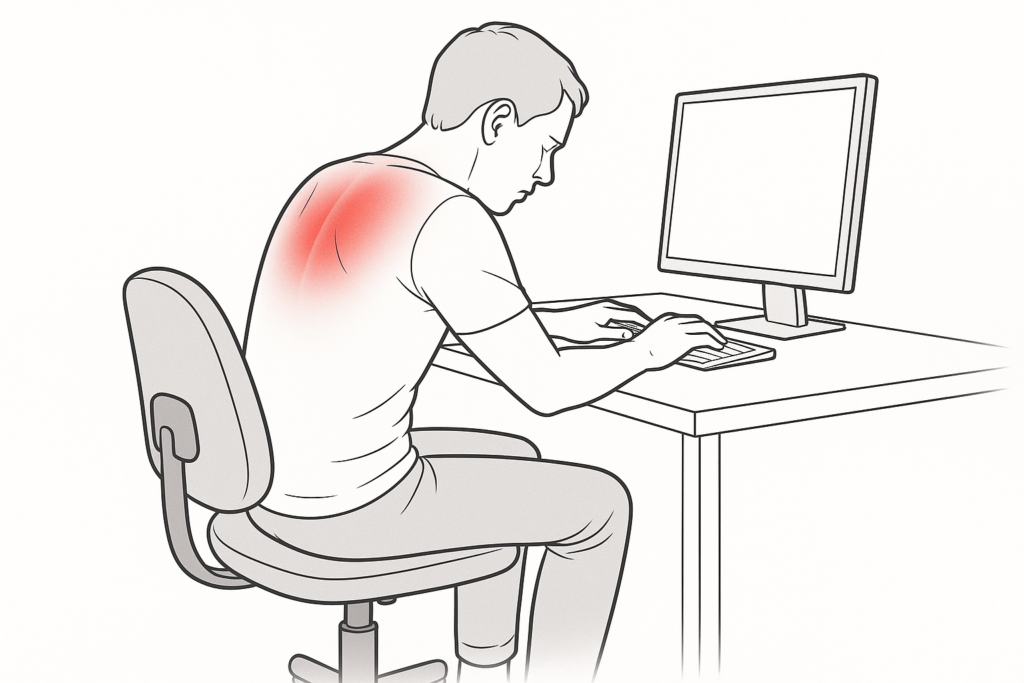Pain in between the shoulder blades can result from muscle strain, poor posture, or spine issues. However, in some cases, it may signal underlying organ-related problems such as heart disease, gallbladder issues, or lung conditions. If pain is sudden, severe, or paired with chest pain, nausea, or shortness of breath, seek immediate medical care.
What Causes Pain Between the Shoulder Blades?
Most people experience shoulder blade pain due to musculoskeletal issues, but in certain cases, it may indicate a deeper medical concern. Below are the main categories of causes:
1. Musculoskeletal Causes (Most Common)
- Poor posture from long hours at a desk
- Muscle strain from lifting heavy objects or exercise
- Herniated or bulging discs in the upper spine
- Arthritis in cervical or thoracic spine joints
Example:
A Lahore-based IT professional developed persistent shoulder blade pain due to slouching at his workstation. After correcting posture and doing daily stretches, his pain reduced by 70% in four weeks.
2. Organ-Related Causes (More Serious)
Pain in this area may be referred pain from internal organs.
| Organ/System | How It Causes Pain Between Shoulder Blades | Warning Signs |
|---|---|---|
| Heart (Angina, Heart Attack) | Nerve pathways may refer pain to the upper back | Chest pain, sweating, shortness of breath |
| Gallbladder (Gallstones, Biliary colic) | Pain radiates to right shoulder blade area | Nausea, pain after fatty meals |
| Lungs (Pulmonary embolism, Pleurisy, Lung cancer) | Irritation of lung lining can cause sharp pain | Cough, shortness of breath, coughing blood |
| Stomach/Esophagus (GERD, Ulcer) | Acid reflux or ulcers may trigger referred pain | Burning sensation, indigestion |
| Liver | Enlargement or inflammation can radiate pain | Fatigue, jaundice, right upper abdominal pain |
What Organ Can Cause Pain Between Shoulder Blades?
Several organs can trigger referred pain here:
- Heart (cardiac conditions) → especially if pain is sudden, crushing, or linked to exertion.
- Gallbladder → right shoulder blade pain after meals.
- Lungs → sharp pain worsened by deep breathing or coughing.
- Stomach/Esophagus → acid reflux-related discomfort.
⚠️ Important: If pain is severe, unexplained, or accompanied by systemic symptoms, do not ignore it — get medical help immediately.
When to See a Doctor
Seek urgent care if your pain:
- Is sudden, severe, or crushing
- Radiates to your chest, jaw, or left arm
- Comes with shortness of breath, dizziness, or nausea
- Persists despite rest and over-the-counter medication
For chronic or mild cases, a doctor may recommend:
- X-rays or MRI to check spine and muscles
- Blood tests or ultrasound to rule out organ issues
- Lifestyle changes such as posture correction, exercise, and diet adjustments

Key Takeaways
- Common causes: poor posture, muscle strain, herniated discs
- Serious causes: heart disease, gallbladder issues, lung problems
- Act fast if pain is sudden, severe, or linked with chest symptoms
- Local example: Desk workers in Pakistan frequently face posture-related shoulder blade pain due to long working hours
- Solution: Correct posture, strengthen back muscles, and seek medical evaluation if pain persists
FAQ
Q1: What causes pain between the shoulder blades?
A: Most commonly muscle strain, poor posture, or spinal issues. In rarer cases, it could be due to heart, gallbladder, or lung conditions.
Q2: What organ can cause pain between shoulder blades?
A: The heart, gallbladder, lungs, stomach, and liver can all cause referred pain in this area.
Q3: Is pain between the shoulder blades serious?
A: Usually not, but it can be. If accompanied by chest pain, dizziness, or shortness of breath, it may be life-threatening.

